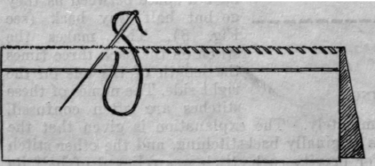No. 11. Overcasting.
Description
This section is from the book "A Sewing Course For Teachers", by Mary Schenck Woolman. Also available from Amazon: A sewing course for teachers.
No. 11. Overcasting.
Materials For Practice
Raw Edges of the Practice Pieces. Cotton No. 60. Needle No. 9.
Application
On the seams of articles or garments. See No. 23. Use. - To keep the raw edges of materials from raveling. Fitness. - The form is adapted to hold threads from raveling without making the raw edge stiff.
Rule
The stitch is loose and slanting, and taken over the raw edges of material. It is made usually from right to left (some prefer to make it from left to right). The stitches are of equal size, the depth and distance apart depend on the character of the material, the object is merely to keep it from raveling (see Fig. 9). Begin with a knot. In seams conceal it between the raw edges. Hold the work over the first finger, or the first and second fingers of the left hand. Place the needle over the raw edges and through the material, slanting it toward the left shoulder. The stitches should always be the same distance from the raw edge and the same distance apart. When a new thread is necessary, insert the needle as if to take a new stitch, withdraw it, and fasten off on the wrong side where the hole was punctured by the needle. Begin the new thread with a knot, insert it between the raw edges, and bring the thread to the right side where the punctured hole was made and continue the stitch as though it had never been interrupted. When turning a corner, put the first stitch around the corner in the same hole as the previous one; this will make a V-shaped stitch in the corner and a neat turn.

Fig. 9. - Overcasting.
Practice
On any of the former practice pieces. Let the stitch be small, and as far apart as will be consistent with the danger of raveling. Seams may be overcast together or separately; in the latter case the seams should be pressed apart after the work is completed. Overcast bias seams from the wide end to the narrow, as they are thus less apt to ravel.
Suggestion
Overcasting is an attractive stitch on canvas; it is easy for little children to learn and may be used by them on burlap mats to keep the fringe from raveling. It is better to make the stitch before fringing out the burlap. The blanket stitch may be contrasted with overcasting as a means to hold raw edges. It is well to give the children a choice in the way of finishing mats.
It can also be used in making an iron holder or pan lifter. Take two squares of denim, turn narrow folds 1/4 inch on the four sides of each so that when the two squares are laid one upon the other they will match in size, lay a piece of woolen cloth or thin ingrain carpet between the two pieces, baste them together, so that the raw edges are inside, with large stitches. Overcast the two pieces together using coarse linen thread of a contrasting color. After the stitch has been made on all four sides, return in the opposite direction, thus making a coarse cross-stitch. In the pan lifter sew a piece of tape about 1/2 a yard long to one corner with the stitching or overhanding stitch (see No. 33), so that it may be fastened to the belt of the worker.
Overcasting is a freehand stitch and often requires much practice to accomplish it easily. It should finally be done very rapidly. All articles and garments having raw edges inside should be finished by overcasting before laying them aside. If the practice pieces are to be kept they also should be neatly overcast.
Continue to:


